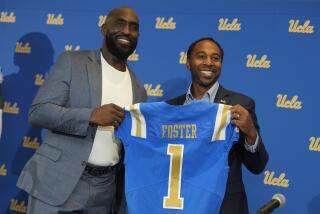Young on UC Fees
- Share via
The Dec. 26 commentary by UCLA’s Chancellor Charles Young is right on the mark. No college student at either state institutions or well-endowed private ones pays the full cost of his or her education; the subsidy from either the taxpayers or private donors is substantial. That wealthier families should receive less of a subsidy so that greater subsidies can be provided to those students (and their families) who qualify for financial aid is, as Young points out, both fair and consistent with higher education’s commitment to broad access.
This fairness principle, however, is achieved only if the financial aid is awarded based upon need. Increasingly, private colleges and universities, and some public universities, are using financial aid awards to lure the most academically qualified students, including many from affluent families who can well afford the tuition. In the college admissions business, these are called “merit scholarships” and contrast sharply with “need-based scholarships.” When tuition funds from Peter are used to attract Paul, the academic superstar, who typically comes from a more affluent family that has been able to provide him or her with a superior high school education and demonstrates no need for financial aid, then the fairness principle breaks down.
Those who provide funds for scholarships--whether full-tuition-paying students, donors, or taxpayers--should be certain that the scholarships they support are awarded upon the basis of financial need, and do not represent simply a price discount to lure certain students in preference to others.
HENRY E. RIGGS, President
Harvey Mudd College, Claremont
Young argues in essence that if the concept of progressive income taxation has evaporated in American society and California and there is no longer a commitment to tuition-free admission to the best qualified, UC must institute its own “progressive user’s tax,” called fees and justified by the “afforability model.” What happens at crunch time? Does the “affordability model” and its social and financial micro-engineering become, in reality, “We will let in just enough unqualified rich students so that we can subsidize a politically correct number of unqualified targets of affirmative action balanced by some highly qualified students in the middle”? It is hard to imagine that the top universities in Japan, Singapore or elsewhere in Asia are using such a gerrymandered formula.
If California wants to sustain its competitiveness in the world economy in a technological era, its university system ought to admit the most academically qualified students, period.
DENNIS M. RAY
Laguna Niguel
More to Read
Sign up for Essential California
The most important California stories and recommendations in your inbox every morning.
You may occasionally receive promotional content from the Los Angeles Times.













